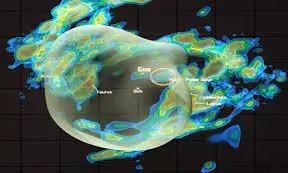
Newly found molecular cloud near Earth may change how we study star formation
text_fieldsAstronomers have identified the closest known molecular cloud to Earth - a vast crescent-shaped mass of hydrogen gas named Eos.
It is located just 300 light-years away.
This discovery is offering scientists a unique and intimate opportunity to study the early stages of star and planet formation.
Named after the Greek goddess of dawn, Eos spans nearly 100 light-years in width, appearing as wide as 40 full moons lined up across the sky. Despite its size and proximity, the cloud had remained hidden from detection until now.
Traditionally, molecular clouds are spotted by detecting carbon monoxide (CO), a bright tracer commonly used in astronomy. However, Eos has very little CO, which made it practically invisible to conventional observational methods. Instead, researchers detected it through the faint fluorescence emitted by hydrogen molecules - a technique that could uncover many more “CO-dark” clouds throughout our galaxy.
"This discovery opens a new window into understanding molecular clouds," said Burkhart, a co-author of the study published in Nature Astronomy. "There definitely are more CO-dark clouds waiting to be discovered."
Eos appears to have been shaped by the North Polar Spur, a giant arc of energised gas, which seems to have influenced its current form. The alignment suggests that radiation and energy from this structure molded the surrounding hydrogen into Eos’s striking crescent shape.
Though it’s not yet actively forming stars, the cloud is not expected to last forever. Scientists estimate that Eos will be broken down in about six million years by intense radiation and cosmic rays. Whether it will produce new stars before then remains uncertain.
In response to the discovery, NASA is developing a spacecraft - also named Eos - designed to observe far-ultraviolet light. Its mission will be to analyse hydrogen content in molecular clouds across the Milky Way, helping scientists better understand regions of the galaxy that were previously undetectable through traditional means.












